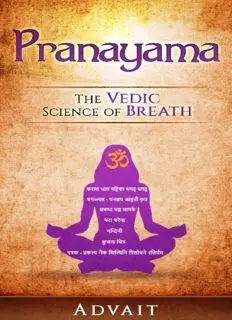
Pranayama: The Vedic Science of Breath: 14 Ultimate Breathing Techniques to Calm Your Mind, Relieve Stress and Heal Your Body PDF
Preview Pranayama: The Vedic Science of Breath: 14 Ultimate Breathing Techniques to Calm Your Mind, Relieve Stress and Heal Your Body
‘Pranayama’ * The Vedic Science of Breath * 14 Ultimate Breathing Techniques to Calm Your Mind, Relieve Stress and Heal Your Body Advait Copyright © 2017, Advait. All rights reserved. Contents A Brief History of Yoga Introduction Some Important Terminologies Seating Position for performing Pranayama Pranayama #1 Pranayama #2 Pranayama #3 Pranayama #4 Pranayama #5 Pranayama #6 Pranayama #7 Pranayama #8 Pranayama #9 Pranayama #10 Pranayama #11 Pranayama #12 Pranayama #13 Pranayama #14 What’s Next? Thank You!! BOOK EXCERPT : “Mudras for Beginners” Other books on Mudras by Advait Disclaimer and FTC Notice A Brief History of Yoga Before starting let’s look back at where it all began. To tell you the truth…. No one knows!! The foundation of Yoga as a science is attributed to Maharshi Patanjali who lived in India in the 3rd Century B.C. But, archeological excavations in the Indus Valley civilization sites have unearthed sculptures and idols depicting various Asanas (physical exercise positions) suggested in Yoga and these idols date back to around 3000 years B.C. Also, information about various aspects of Yoga can be found in Vedic texts like; Shwetashwatrupanishad, Chaandogyopanishad, Kaushitki Upanishad, Maitri Upanishad etc. This information was scattered all over and Maharshi Patanjali, compiled these nuggets into a streamlined and strict science of Yoga or should I say he compiled this scattered information into a way of life called Yoga through his work ‘Paatanjal YogaSutra’ After Maharshi Patanjali, Maharshi Swatwaram wrote ‘Hatapradipika’ (meaning - One Which Illuminates the Path of Hatha Yoga , i.e. the physical aspect of Yoga) in the 13th Century A.D. And, Maharshi Gherand wrote ‘Gherandsanhita’ around the same time. Almost all the Yoga methodologies practiced world-over today regard Maharshi Patanjali’s work as their reference. Free 5 Day email course "Advanced Pranayama Techniques" email course This book covers 14 different breathing techniques which are more common, traditional and suitable for beginners and intermediate practitioners alike. But, once you learn these techniques, you are ready for the next step. Peculiar breathing methodologies which I call, “Advanced Pranayama Techniques”, are the ones where we incorporate ‘Micro-Exercises’ called as sukshma-asanas along with regulated breathing patterns to circulate and fill ‘Prana’ energy in a particular part of our body, thus nourishing the related organs and enhancing the overall vitality and self-healing capability of our body. I have compiled 5 such advanced breathing techniques, into a 5 day email course . And, I am offering the online email course, for FREE to my readers only. Get your Free, 5 day email course, “Advanced Pranayama Techniques” here. Some Important Terminologies Here are some terminologies you’ll come across in this book: Breathing Terminologies- Purak- To inhale in to the full capacity of your lungs. Also, when you inhale don’t expand your stomach instead fill all the air in your chest. Kumbhak- (‘Kumbh’ means a pot or a round utensil) To hold the inhaled air in your lungs. Rechak- To exhale every ounce of air out of your lungs. Bandh or Lock terminologies- Jalandhar Bandh - To close your wind pipe by pressing your chin against the base of your neck. Uddiyan Bandh- To contract your abdomen and try to suck in your stomach so that it will touch your spine. Mula Bandh- To pull in your anal muscles. (it is as if you have to go to the toilet but are not able to find one nearby and you have to hold it in.) Let’s get down to business… Seating Position for performing Pranayama Most of the Pranayama are to be performed while sitting in ‘Sukhasan’ position. Sukhasan (the Simple Sitting Pose) -Sit on the mat with your legs stretched in front. -Fold the right leg and tug in below the left thigh. -Then, fold the left leg and tug it between the right thigh and calf. -Sit straight with an erect spine. (It is how we generally sit on the floor and fold our legs.) Pranayama #1 Bhastrika Pranayama/ Bellow Breath Method: Sit in Sukhasan and form the dnyanamudra with your hands and place them on your knees with your palms facing upwards. (‘Dnyanamudra’ is formed when you join the tips of your index finger and your thumb while keeping your other fingers outstretched.) Close your eyes . Inhale to your full capacity; hold the breath in for a couple of seconds and then exhale slowly. When you inhale, fill the air into your lungs and expand your chest while inhaling and it will press your diaphragm down; Do not expand your stomach while inhaling. Concentrate completely on your breathing and pay attention to how you feel with every breath you take. Visualize, every breath nourishing all the parts of your body. Duration: Perform this Pranayama for at least 3 minutes. Uses: -This is a nourishing exercise and it enhances your digestive capabilities and creates heat in the body. -It helps in burning the excess fat. -It helps in reducing the amount of phlegm. -It is very effective in cases of Asthma. -It strengthens your Lungs. -It helps in purifying blood and facilitates efficient blood circulation.
